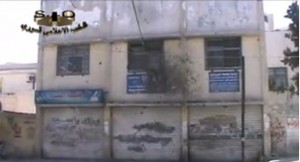The Future of a Generation Hangs in the Balance as War Comes to Damascus

Editor’s Note: All names are pseudonyms
At the Nahr Aisha checkpoint at the southern entrance to Damascus, 10-year-old Maher moves along the endless queue of cars that are waiting to cross into Damascus, asking drivers and passengers to buy one of the several cigarette packs he is holding.
His father is sits on the sidewalk preparing coffee and tea to sell to drivers, while two children, not much older than Maher, deliver cups to the waiting customers.

“Those are my brothers. We left school over a year ago, after we fled Buwaida,” said Maher, referring to small town in the Damascus countryside that has witnessed fierce battles between the rebels and the regime.
Maher is just one of many children peddling everything from bread, cookies, cigarettes, coffee or tea on the streets in and around Damascus. Most of them have been displaced from their homes, and all are being denied the basic rights of childhood, including the right to education. The war in Syria is consuming their dreams and futures.
The United Nations Children’s Fund, UNICEF, estimates that 2 million out of 4 million children inside Syria have been affected, in addition to the 800 thousand children out of 2 million internally displaced Syrians, and the 500 thousand more children who are refugees in Turkey, Lebanon, and Jordan. It is important to note that all these numbers are on the rise as refugees continue to flow into those countries. Altogether, the number of children affected by the war exceeds 3.3 million and school dropout rates have been rising as well.
“My kids have not gone to school since we left Darayya last year,” said Souad, 43, a housewife who now resides in Sehnaya near Damascus with her family. “We left our homes, carrying nothing but our souls. When the clashes and shelling got really bad, we were forced to flee, and we did not take the children’s school paperwork with us.”
Despite a decree by the Minister of Education to facilitate the admission of displaced students, even those without proper paperwork, Souad said the school principals refused to register her children. She believes they discriminated against her family because they are from Darayya, one of the most famous strongholds of the opposition.
“Schools are suffering due to the huge influx of students, teachers and technicians transferring in from other schools that were closed. This affects the educational process, in addition to the constant threat of closure depending on the security situation,” said Samir, 56, a teacher at a school in Sehnaya.
Many Syrian children have been forced to travel long distances to continue their education after the schools in their areas closed.
When The Damascus Bureau met Ahmed, 14, a middle-school student, he said he walks no less than three kilometres every day to get from Al-Sbaina, a town just south of Damascus, to a place where he can get a ride to the town of Sehnaya, where his new school is located.
“I do not want to leave my studies,” he said. “This is an important year for me.”
All schools in Al-Sbaina were closed due to heavy shelling by both regime troops and the Free Syrian Army, the FSA. Some schools in the nearby town of Hujaira have been turned into FSA headquarters.
According to UNICEF, one out of every five schools in Syria – about 2,445 out of 22,000 – have been damaged as a result of armed conflict. The organization estimates that around 1,899 schools are being used as centres to house refugees, which is not a promising sign for the educational future of children in Syria.
“My parents stopped sending me to school after a shell landed nearby, killing my brother and some of the other students,” said Sana, 12, whose family fled Al-Sbaina for Al-Kaswa. “It’s our family’s right to be scared for us, but this fear will rob us of our future.”
Today, Sana stays home and helps her mother do the shopping and raise her younger siblings.
Students are not the only ones affected by the violence. Many press reports have recorded teachers being killed or wounded as well.
The Ministry of Education, in coordination with UNICEF, has come up with a plan that aims to return some 500 thousand elementary and high school students to school. The program includes extra support classes and social and psychological support services. The ministry has also uploaded digital copies of most textbooks onto its website, while UNICEF, together with some school clubs, will offer remedial classes to about 150,000 children.
Many are sceptical of the program, however. Shaimaa, 26, a teacher at Al-Kaswa, said the ministry’s plan is unrealistic.
“The state of chaos in the country affects everything, and the Ministry of Education is the most out of touch with reality,” she said. “How are students supposed to access electronic versions of their books when the Internet is barely working and very weak in some areas, and loading even a single page is difficult? Do our students even have computers?”
“It would have been better if they had focused on more feasible steps that would benefit the greatest number of students across all regions, such as [amending?] the curriculum, setting dates for exams, writing different exam questions and providing uniforms and basic school supplies,” she said.
With fighting continuing in most parts of Damascus, the future of thousands of students hangs in the balance.
Sana, 35, said she did not allow her daughter to go to school because she was afraid of losing “another one of my children.”
“Education is important but their lives are more important,” she explains. “Many children were kidnapped on their way to school, and some, like my son, were killed by shells. Our lives have been much harder since we left home, and I cannot take on any additional burdens, such as the danger of my children going to school.”
